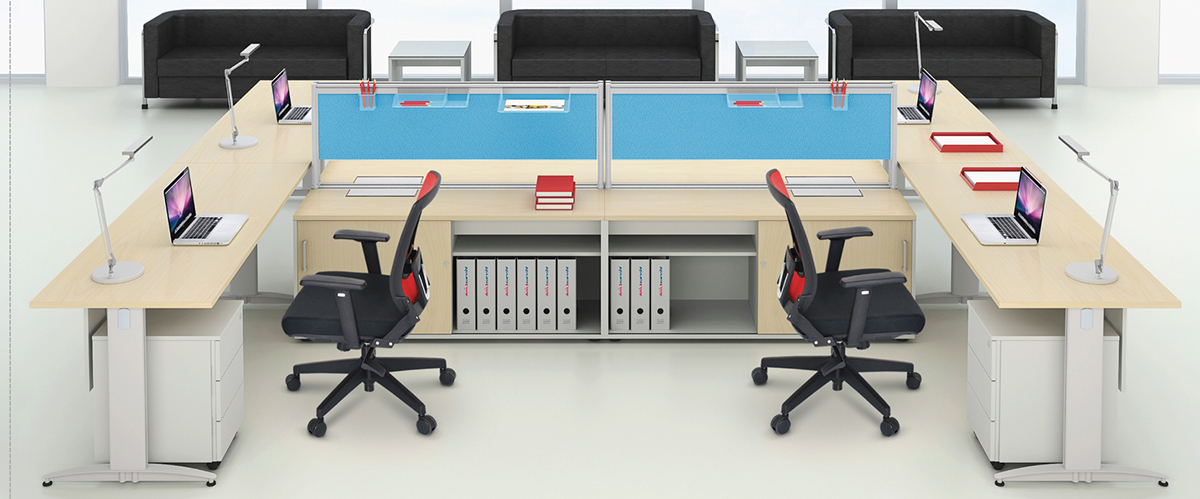Transform Your Workplace with Collaborative Office Furniture Ideas
Collaboration is key to driving innovation and achieving organizational success. Creating a workplace that fosters requires careful consideration of office furniture and design. By implementing collaborative office furniture solutions, you can transform your workplace into a hub of creativity, productivity, and teamwork.

In this article, we will explore some inspiring ideas that can help you create an environment that promotes and enhances overall employee satisfaction.
-
Open-Concept Workstations:
Gone are the days of isolated cubicles. Open-concept workstations have gained popularity due to their ability to encourage communication among team members. By opting for shared workspaces with modular desks or benching systems, you can facilitate impromptu discussions, idea sharing, and easy access to colleagues. This setup also promotes a sense of camaraderie and breaks down barriers between departments.
-
Collaborative Lounge Areas:
Integrating comfortable and inviting lounge areas within your office space can do wonders for collaboration. These areas can feature soft seating options like sofas, armchairs, and ottomans, arranged in a way that encourages informal meetings and brainstorming sessions. By providing employees with relaxed and inspiring spaces, you create an atmosphere conducive to free-flowing conversations, idea generation, and relationship-building.
-
Mobile and Adjustable Furniture:
Flexibility is crucial when it comes to workspaces. Invest in furniture that is mobile and adjustable, such as modular desks, rolling whiteboards, and height-adjustable tables. This allows employees to easily reconfigure the furniture layout based on their specific needs. Mobile furniture enables teams to create temporary meeting areas, and collaborative pods, or reorganize the space for larger group discussions, fostering adaptability and teamwork.
-
Collaboration Pods:
Designated collaboration pods or huddle spaces are excellent additions to any office environment. These semi-enclosed areas equipped with comfortable seating, whiteboards, and audiovisual technology provide private yet open spaces for small group discussions and brainstorming sessions. Pods offer a balance between privacy and accessibility, ensuring employees have a dedicated space to collaborate without interruptions.
-
Technology Integration:
To facilitate effective collaboration, incorporating the right technology is essential. Equip your spaces with video conferencing equipment, large interactive displays, and wireless connectivity solutions. These tools enable teams to collaborate seamlessly with remote colleagues, share presentations, and work on projects in real-time. By integrating technology into collaborative furniture, you bridge the gap between physical and virtual collaboration, ensuring everyone can contribute regardless of their location.
-
Standing Desks and Shared Work Surfaces:
Standing desks have gained popularity due to their health benefits and their ability to promote. Providing employees with the option to work while standing not only encourages movement but also facilitates impromptu discussions and idea exchanges. Additionally, shared work surfaces, such as communal tables or sit-stand benches, create an environment that promotes teamwork and breaks down hierarchical barriers.
Benefits of Collaboration in the Workplace
Collaboration in the workplace offers numerous benefits that can significantly impact productivity, creativity, employee satisfaction, and overall business success.
Here are some key benefits of fostering it:
-
Enhanced Problem Solving and Innovation: Collaboration brings together diverse perspectives, skills, and expertise. When individuals from different backgrounds and departments collaborate, they can offer unique insights and ideas. This diversity of thought leads to more effective problem-solving and innovative solutions. Collaborative environments encourage brainstorming, constructive feedback, and the exploration of new approaches, driving creativity and pushing boundaries.
-
Increased Productivity: Collaboration promotes efficient teamwork and task completion. By working together, employees can share the workload, leverage each other's strengths, and divide complex projects into manageable tasks. Environments encourage accountability, as team members support and motivate each other to meet deadlines and achieve common goals. This shared responsibility and mutual support lead to increased productivity and improved work efficiency.
-
Knowledge Sharing and Skill Development: Collaborative workplaces foster a culture of continuous learning and growth. When employees collaborate, they have the opportunity to share their knowledge, expertise, and best practices with others. This knowledge sharing not only helps solve immediate challenges but also contributes to the development of new skills and competencies. Collaborative environments encourage cross-training, mentorship, and peer-to-peer learning, allowing employees to expand their knowledge base and become more well-rounded professionals.
-
Improved Communication and Coordination: Collaboration requires effective communication and coordination among team members. By working together, employees develop stronger communication skills, learn to express their ideas clearly, actively listen to others, and provide constructive feedback. Collaborative environments often utilize various communication tools and platforms to facilitate seamless information exchange, ensuring everyone is on the same page. Improved communication and coordination reduce misunderstandings, minimize conflicts, and enhance overall team performance.
-
Boosted Employee Engagement and Satisfaction: Collaborative workplaces foster a sense of belonging and teamwork. When employees feel included and valued team, they are more engaged and motivated to contribute their best efforts. It allows individuals to connect with colleagues, build relationships, and develop a support system. This positive work environment leads to increased job satisfaction, employee retention, and overall well-being.
-
Faster Decision-Making: By involving multiple perspectives and ideas, teams can evaluate options more comprehensively and make informed decisions. Collaboration allows for the pooling of expertise, resulting in well-rounded decisions that consider various factors and potential outcomes. Additionally, team decision-making often leads to better buy-in and acceptance from team members, as they feel involved and invested in the process.
-
Adaptability and Agility: Collaborative workplaces promote adaptability and agility by fostering a culture of learning, flexibility, and open-mindedness. Teams that collaborate can quickly respond to challenges, seize opportunities, and adapt their strategies based on changing market conditions. Collaboration encourages continuous improvement, experimentation, and the ability to embrace change, giving organizations a competitive edge.
Conclusion:
Investing in collaborative office furniture can transform your workplace into a dynamic and engaging environment that fuels creativity, innovation, and teamwork. By implementing open-concept workstations, lounge areas, mobile and adjustable furniture, collaboration pods, technology integration, and standing desks, you create an office space that fosters collaboration, increases productivity, and boosts overall employee satisfaction. Remember, a well-designed workplace can be a catalyst for success, driving your organization towards greater achievements and growth.
- 23.05.2023